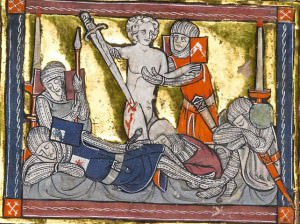Women, Suicide, and the Jury in Later Medieval England
Sara M. Butler
Signs: Journal of Women in Culture and Society, vol. 32: 1 (2006)
Abstract
The image of the possessed woman eventually driven to suicide by the malevolent urgings of her inner demons was a powerful one and familiar throughout the medieval world, but just how dominant an image was it when it came to dealing with actual cases of self-killing? Were medieval jurors more inclined to condemn female self-killers to a suicide’s death because of the familiar figure of the mad, possessed woman?
Introduction: In the year 1397 in the parish of Tuttington (Norfolk), a woman whose name is lost to history, frantic to rid herself of the evil spirit that possessed her, turned to suicide. She attempted first to hang herself, but her husband discovered her while life remained in her body, cut down the rope, and comforted her. A few weeks later she tried once again to hang herself, but the rope broke. As soon as she had regained her breath, she raced to a nearby pond, reported to be at least six or seven feet deep, and leaped in with the aim of drowning herself, but even though her head submerged three times, she was not able to sink. She struggled out of the pond and walked to the home of her sister to tell her about the day’s events. Her sister begged her to confess to the local priest, convinced that only through confession might she drive away the malevolent spirit. The sister then kindly put the woman to bed and rushed off to the woman’s house for dry clothes to make her more comfortable. After her sister had departed, the woman decided to make one last attempt. She found a small dagger hanging on the wall of the cottage, and she stabbed herself three times in the stomach. Still she did not die. When she finally understood that the spirit was preventing her from taking her life, the woman tried to cut out her heart, assuming that her body could not live without it.
The blade was insufficient for the task, however, and she had to settle for enlarging the original wound, pulling out her intestines, and strewing them about the room. By the time her sister arrived back with the parish priest in tow, the room had the appearance of a grisly murder scene, yet without a victim. The woman had been driven mad, rolling her flashing eyes about in her head. After he had overcome his initial shock, the priest assumed control of the room: he commanded the wild woman to think of God and to cast out her despair. He then urged her to confess her sins, promising her forgiveness; she did so, receiving a suitable penance and the viaticum. Only then was she able to find the peace she so desperately sought. She lived three more hours, and then died, choosing God’s mercy.
Women, Suicide, and the Jury in Later Medieval England
Sara M. Butler
Signs: Journal of Women in Culture and Society, vol. 32: 1 (2006)
Abstract
The image of the possessed woman eventually driven to suicide by the malevolent urgings of her inner demons was a powerful one and familiar throughout the medieval world, but just how dominant an image was it when it came to dealing with actual cases of self-killing? Were medieval jurors more inclined to condemn female self-killers to a suicide’s death because of the familiar figure of the mad, possessed woman?
Introduction: In the year 1397 in the parish of Tuttington (Norfolk), a woman whose name is lost to history, frantic to rid herself of the evil spirit that possessed her, turned to suicide. She attempted first to hang herself, but her husband discovered her while life remained in her body, cut down the rope, and comforted her. A few weeks later she tried once again to hang herself, but the rope broke. As soon as she had regained her breath, she raced to a nearby pond, reported to be at least six or seven feet deep, and leaped in with the aim of drowning herself, but even though her head submerged three times, she was not able to sink. She struggled out of the pond and walked to the home of her sister to tell her about the day’s events. Her sister begged her to confess to the local priest, convinced that only through confession might she drive away the malevolent spirit. The sister then kindly put the woman to bed and rushed off to the woman’s house for dry clothes to make her more comfortable. After her sister had departed, the woman decided to make one last attempt. She found a small dagger hanging on the wall of the cottage, and she stabbed herself three times in the stomach. Still she did not die. When she finally understood that the spirit was preventing her from taking her life, the woman tried to cut out her heart, assuming that her body could not live without it.
The blade was insufficient for the task, however, and she had to settle for enlarging the original wound, pulling out her intestines, and strewing them about the room. By the time her sister arrived back with the parish priest in tow, the room had the appearance of a grisly murder scene, yet without a victim. The woman had been driven mad, rolling her flashing eyes about in her head. After he had overcome his initial shock, the priest assumed control of the room: he commanded the wild woman to think of God and to cast out her despair. He then urged her to confess her sins, promising her forgiveness; she did so, receiving a suitable penance and the viaticum. Only then was she able to find the peace she so desperately sought. She lived three more hours, and then died, choosing God’s mercy.
Click here to read this article from Academia.edu
Subscribe to Medievalverse
Related Posts